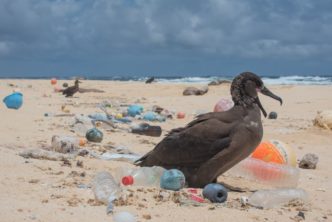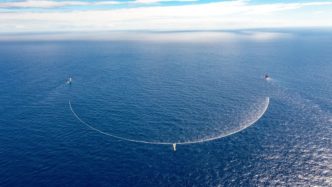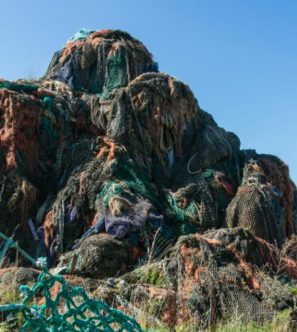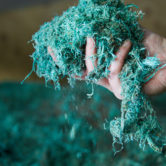May 10, 2025
The oceans harbor not only a beautiful underwater world but, unfortunately, also a growing mountain of plastic waste. Humans produce over 400 million metric tons of plastic annually. That’s roughly the weight of all humans on the planet and plastic production is projected to keep going up. So, of these 400 million tons that gets produced each year, how much actually ends up in the ocean?

This waste poses a threat to marine life and our ecosystems. Fortunately, there are inspiring and emerging initiatives that not only clean up the ocean but also transform the waste into valuable products. One such initiative involves collaboration between various ports in Europe, recycling processes, experts and our company Beologic, resulting in our innovative Ocean range. However, the journey from discarded maritime gear to high-quality compounds is filled with significant challenges at every stage. Let us walk you through it.
Ocean waste collection is no simple task. Unlike other waste streams, maritime gear, such as fishing nets and ropes, is spread across multiple ports worldwide, each with its own regulations and logistical constraints. The challenge begins with the complexity of organizing collection points and ensuring the waste is properly documented and transported.

Fishing nets and maritime ropes, which represent over 55% of the plastic found by the Ocean Cleanup in the Great Pacific Garbage Patch, are particularly circumstantial. These materials are often heavily entangled, contaminated with salt, sand, marine organisms and stored in a way that complicates retrieval. Moreover, the nature of the European ports means that collection is neither centralized nor consistent, making logistics a constant challenge.
Our partners work diligently to streamline this process, ensuring that no fiber goes to waste while preventing ocean-bound plastic pollution at its source.

The process is extremely labour-intensive and requires trained people to identify, classify and separate these materials before they enter the recycling stream. Automating this process is challenging due to the irregularity and entanglement of the materials, making human intervention necessary to ensure quality. Sorting mistakes can compromise the quality of the final recycled product, adding another layer of complexity to an already difficult task.
The robustness of maritime gear, designed to withstand extreme ocean conditions, presents another major obstacle. Fishing nets and ropes are engineered for durability, meaning they resist degradation and require specialized machinery for processing. Unlike conventional plastics, these materials place significant wear and tear on recycling equipment, increasing maintenance costs and operational downtime. There are multiple machines necessary to recycle the different materials.

Before being processed into pellets, the materials must first undergo rigorous cleaning to remove salt deposits, algae and other organic residues. This is followed by mechanical shredding, a step that demands high-performance cutting tools to break down the tough polymer chains. Standard recycling machines are often insufficient, necessitating the use of reinforced cutting mechanisms that can withstand the strain of processing these resilient materials. Which means that multiple machines are necessary to recycle the different materials.
The challenges do not stop at recycling. The resulting plastic pellets often exhibit compromised properties due to prolonged exposure to UV rays, seawater and mechanical stress during their first life cycle. These environmental factors break down the polymer chains, resulting in weaker material characteristics that require reinforcement.
But, once recycled, companies like us, Beologic, spring into action. The recycled material is used as raw
material to develop new compounds. These high-quality compounds become the building blocks for a variety of products. Thanks to our expertise in material science, plastic analysis and innovation, we can form a bridge between a recycled material with low properties and a performant product. Our compounding process involves advanced formulations to restore the structural integrity of the polymer, ensuring it meets industry standards for durability and usability. The addition of impact modifiers, UV stabilizers, and processing aids is crucial to making the recycled material viable for high-performance applications. Without these interventions, the recycled plastics would be too brittle or inconsistent for meaningful reuse.
In close cooperation with our customers, we make sure that our compounds check the quality standards required for further processing and the final product. We require all our partners to provide reliable, transparent and verifiable evidence on the recycling and ESG impact, enabling us to offer our consumers transparent proof of our sustainability efforts, not just unverified claims.
The whole supply chain of our Ocean range is third party verified by Recyclass to ensure the recycled content of our materials. By collecting data along the whole value chain, we are also able to present the product carbon footprint of all our materials.
Despite these challenges, the recycled compounds created through our Ocean range are finally transformed into innovative, sustainable products through exceptional partnerships. These recycled materials have been used in:
These projects demonstrate that waste from the ocean can not only gain a second life but also become a symbol of circular innovation and sustainable design.
The transformation of ocean waste into valuable products is more than just recycling, it is about redefining the possibilities of waste recovery. By overcoming significant logistical, mechanical, and material challenges, we are proving that a circular economy is achievable and that companies can contribute to this. Not only does this process prevent valuable materials from being lost, but it also plays a crucial role in reducing ocean plastic pollution while delivering high-quality sustainable solutions. Furthermore, it highlights that sustainability and innovation can go hand in hand.
The transformation of ocean waste into valuable products proves what is achievable with the right vision and technology. Together with our partners, we aim to inspire everyone to view waste differently and believe in a future where waste no longer exists.
The next time you see a sustainable bicycle, or another product made of recycled materials, remember that it might once have been a fishing net, which has been saved from ghosting in our oceans. Thanks to initiatives like this, waste can not only be removed from nature but also transformed into something meaningful, for the planet and for all of us.